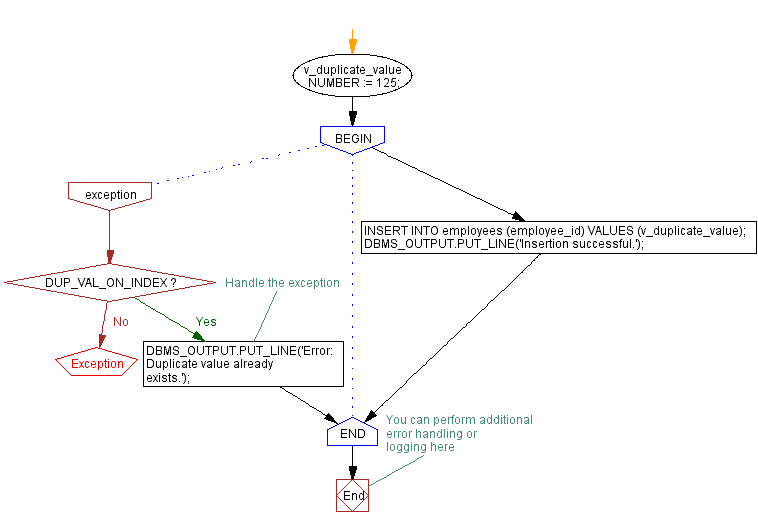Handling DUP_VAL_ON_INDEX exception in PL/SQL
PL/SQL Exception Handling: Exercise-5 with Solution
Handle the DUP_VAL_ON_INDEX exception when inserting a duplicate value into a table with a unique constraint.
Sample Solution:
Table: employees
employee_id integer first_name varchar(25) last_name varchar(25) email archar(25) phone_number varchar(15) hire_date date job_id varchar(25) salary integer commission_pct decimal(5,2) manager_id integer department_id integer
Example-1
PL/SQL Code:
DECLARE
v_duplicate_value NUMBER := 125;
BEGIN
BEGIN
INSERT INTO employees (employee_id) VALUES (v_duplicate_value);
DBMS_OUTPUT.PUT_LINE('Insertion successful.');
EXCEPTION
WHEN DUP_VAL_ON_INDEX THEN
-- Handle the exception
DBMS_OUTPUT.PUT_LINE('Error: Duplicate value already exists.');
-- You can perform additional error handling or logging here
END;
END;
/
Sample Output:
Error: Duplicate value already exists.
Explanation:
The said code in Oracle's PL/SQL demonstrates to handle the scenario where a duplicate value is being inserted into a table with a unique constraint and by catching the DUP_VAL_ON_INDEX exception an appropriate error handling message is displayed.
A variable v_duplicate_value is declared and assigned a value of 125, representing a duplicate value that is being attempted to be inserted.
The nested BEGIN...EXCEPTION...END block that performs to insert the value of v_duplicate_value into the "employee_id" column in 'employees' table.
If the insertion is successful, the code prints a successful message and however, if fails due to a violation of the unique constraint, the DUP_VAL_ON_INDEX exception is raised, and the inner EXCEPTION block is triggered and an error message that is, a duplicate value already exists is printed to the console.
Flowchart:

Table: departments
department_id integer department_name varchar(25) manager_id integer location_id integer
Example-2
PL/SQL Code:
DECLARE
v_department_iddepartments.department_id%TYPE := 90;
v_department_namedepartments.department_name%TYPE := 'Research';
v_manager_idemployees.employee_id%TYPE := 110;
v_location_idlocations.location_id%TYPE := 1700;
BEGIN
INSERT INTO departments (department_id, department_name, manager_id, location_id)
VALUES (v_department_id, v_department_name, v_manager_id, v_location_id);
EXCEPTION
WHEN DUP_VAL_ON_INDEX THEN
DBMS_OUTPUT.PUT_LINE('Caught DUP_VAL_ON_INDEX exception: Violation of a unique key constraint.');
WHEN OTHERS THEN
DBMS_OUTPUT.PUT_LINE('An error occurred: ' || SQLERRM);
END;
Sample Output:
Caught DUP_VAL_ON_INDEX exception: Violation of a unique key constraint.
Explanation:
The said code in Oracle's PL/SQL that demonstrates how to handle the DUP_VAL_ON_INDEX exception specifically and provides a mechanism for handling other exceptions that might occur during the execution of the INSERT statement.
The variables v_department_id, v_department_name, v_manager_id, and v_location_id are declared. These variables hold the values that will be inserted into the departments table.
The INSERT statement is executes to insert a new record into the departments table using the declared variables.
If the INSERT statement violates a unique key constraint, specifically the duplication of a value in an indexed column, the DUP_VAL_ON_INDEX exception is raised and the corresponding exception handler provides the message indicating the violation of the unique key constraint.
If the exception handler catches any other exceptions that might occur during the execution of the block it outputs a general error message that includes the error information obtained using the SQLERRM function.
Flowchart:

Go to:
PREV : Handling invalid number exception in PL/SQL.
NEXT : Handling VALUE_ERROR exception in PL/SQL: Code Example.
Have another way to solve this solution? Contribute your code (and comments) through Disqus.
What is the difficulty level of this exercise?
